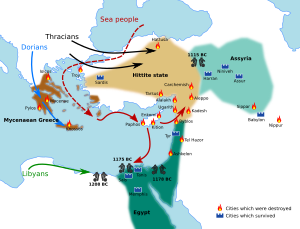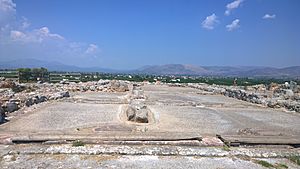Late Bronze Age collapse facts for kids
The Late Bronze Age collapse was a time of big changes and problems that happened around 1200 to 1150 BC. Many ancient civilizations in the Eastern Mediterranean and Near East faced sudden and violent challenges. This period brought a sharp economic decline and led to the start of the Greek Dark Ages.
During this time, the powerful palace systems of Mycenaean Greece, the Aegean region, and Anatolia fell apart. They changed into smaller, more isolated village cultures. The mighty Hittite Empire in Anatolia also collapsed. Other strong states like the Middle Assyrian Empire in Mesopotamia and the New Kingdom of Egypt survived, but they became much weaker. On the other hand, some cultures, like the Phoenicians, became more independent and powerful as Egypt and Assyria had less control in West Asia.
Many ideas have been suggested about what caused the Late Bronze Age collapse. Most theories involve cities and towns being violently destroyed. Some ideas include volcanic eruptions, long periods of drought, widespread disease, earthquakes, invasions by groups like the Sea Peoples or the Dorians, and problems with trade. Changes in how people made iron and new ways of fighting also played a role. It's likely that a combination of these factors led to the collapse.
Contents
What Happened During the Collapse?
The 50 years between 1200 and 1150 BC saw many cultures fall apart. This included the Mycenaean kingdoms, the Kassites in Babylonia, the Hittite Empire in Anatolia and the Levant, and the New Kingdom of Egypt. Cities like Ugarit were destroyed, and the Amorite states in the Levant also broke up. This chaos made it hard for trade routes to work and caused a big drop in how many people could read and write.
Historians used to think that almost every city from Pylos to Gaza was violently destroyed and then left empty. However, newer research shows that many of these destructions were not as widespread or as violent as once thought. Many cities were not destroyed at all, or the damage was not from an attack.
Only a few powerful states managed to survive the Bronze Age collapse. These included Assyria (though it became weaker for a while), the New Kingdom of Egypt (also weaker), the Phoenician city-states, and Elam. Even for these survivors, things were tough.
Some people describe the collapse as "the worst disaster in ancient history." Stories from that time talked about a "lost golden age." For example, the ancient Greek writer Hesiod spoke of different ages, like the Age of Gold and Bronze, which were much better than his own "Age of Iron."
Why Did It Happen?
Many different reasons have been suggested for the collapse. It's likely that several things happened at the same time to cause such a big change.
Environmental Changes
Volcanoes
Some experts believe that a large volcanic eruption in Iceland around 1159 BC might have caused a "volcanic winter." This could have led to famines (times of severe hunger) during the reign of Ramesses III in Egypt, making the collapse worse.
Drought
The Late Bronze Age might have been the driest time in the Mediterranean region. Tree cover decreased, and ancient writings mention large groups of people moving around because of this. In the Dead Sea area, water levels dropped a lot, meaning there was very little rain.
Drought in the Nile Valley could have also made the Sea Peoples move and attack Egypt. Crop failures and hunger from less water might have made Egypt politically unstable. Studies of tree rings show that conditions became drier from the 13th to the 12th century BC. This long-term change in weather would have put constant stress on societies for many generations.
Sickness
Recent findings suggest that an early form of the Bubonic Plague might have arrived from central Asia. This disease could have been brought by the Sea Peoples or other migrating groups. It might have made the collapse of cultures in Mycenaean Greece, Hittite Anatolia, and the Levant much worse.
New Ways of Fighting
Some historians believe that new ways of fighting played a big role. Large groups of foot soldiers (infantry) started using new weapons and armor, like stronger spears and long swords. These new weapons could cut and thrust, making them very effective.
These new weapons, used by many fast-moving fighters, could easily defeat armies that relied on chariots. Chariots were used by the ruling class, so this change in warfare could have made states unstable. This might have led to raiders conquering, looting, and burning cities.
System Breakdown
Another idea is that the societies of the Late Bronze Age became too complex and specialized. Their political, economic, and social systems were so intricate that when something went wrong, it was impossible to fix them piece by piece. This could explain why the collapse was so widespread and why these civilizations couldn't recover easily.
Problems like population growth, poor soil, and new metal technologies could have made weapons too expensive for the traditional warrior leaders. When combined with other issues like peasant revolts, disloyal soldiers, overpopulation, and wars between states, these fragile kingdoms could not handle the pressure. Piracy by the Sea Peoples, which stopped trade, and droughts or crop failures also added to the problems.
Where Did It Happen?
Anatolia

Before the collapse, Anatolia (modern-day Turkey) was home to many different peoples, including the Hittites. The powerful Middle Assyrian Empire had already weakened the Hittites. It was once thought that Hattusa, the Hittite capital, was completely burned by invaders. However, recent studies show that the city was not totally destroyed in a big attack. Instead, only official buildings seemed to have burned, and they were likely emptied first.
Many other sites in Anatolia were abandoned, even if they weren't destroyed. The city of Troy, famous from the Trojan War, was destroyed at least twice during this period before being left empty for a long time. New groups of people, like the Phrygians, arrived in the region.
Sites in Anatolia that show evidence of the collapse include:
Cyprus
The island of Cyprus was briefly invaded by the Hittites around 1200 BC. However, there is little clear evidence of widespread destruction on Cyprus around this time. While some cities like Kition were rebuilt, there's no sign of violent destruction. Some settlements were abandoned without being destroyed.
Interestingly, some areas of Cyprus, like Kition and Paphos, actually seemed to do well after 1200 BC, which was different from most of the Eastern Mediterranean.
Syria
Ancient Syria was a battleground for the Hittites, the Middle Assyrian Empire, and the New Kingdom of Egypt. The Assyrians took control of much of the region. Later, coastal areas were attacked by the Sea Peoples. During this time, new groups like the Arameans became very important in Syria.
Evidence from Ugarit shows that this city was destroyed after 1200 BC. Letters found on clay tablets, baked in the fire that destroyed the city, talk about enemy ships and cities being burned. The king of Ugarit, Ammurapi, wrote about his desperate situation: "My father, behold, the enemy's ships came (here); my cities(?) were burned, and they did evil things in my country."
While Ugarit and Emar were clearly destroyed, many other cities in Syria, like Hama and Aleppo, show no evidence of destruction around 1200 BC.
Sites in Syria that show evidence of the collapse include:
- Ugarit
- Emar
Southern Levant
Egyptian records show that wandering groups like the Shasu caused problems. Ramesses II fought against them. There is little evidence that many major cities in the southern Levant were destroyed around 1200 BC. For example, at Lachish, there was a fire in one house, but the city was rebuilt even grander than before. Many sites, like Ashkelon and Ashdod, were not burned down.
Trade with other regions actually continued after 1200 BC in the Southern Levant. While trade in Cypriot and Mycenaean pottery ended earlier, trade with Egypt and in metals like tin and lead continued.
Sites in the Southern Levant that show evidence of the collapse include:
- Hazor (destruction earlier in the 13th century BC)
- Megiddo (possible palace destruction)
- Lachish (house fire, not widespread destruction)
Greece
In Greece, the destruction was worst at palaces and fortified sites. None of the Mycenaean palaces survived. Thebes was attacked and destroyed by fire. Many small sites in the Peloponnese were abandoned, suggesting a big drop in population.
The city of Mycenae was first hit by an earthquake around 1250 BC. It was rebuilt but then destroyed by major fires around 1190 BC. It's unclear what caused these fires, but there's no strong archaeological proof of an attack. A similar situation happened at Tiryns, where an earthquake destroyed much of the city. However, people continued to live there afterward. This suggests that earthquakes alone didn't permanently destroy these cities.
Pylos shows clearer signs of violent destruction by fire around 1180 BC. Tablets found there mention "Watchers guarding the coast," suggesting they expected an attack from the sea.
The Bronze Age collapse marked the beginning of the Greek Dark Ages, which lasted about 400 years. Cities like Athens continued to exist, but they were much smaller, had less trade, and their culture became poorer. It took centuries for them to recover.
Sites in Greece that show evidence of the collapse include:
Who Survived?
Mesopotamia
The Middle Assyrian Empire (1392–1056 BC) was very powerful before the collapse. It controlled a large empire. Even though some areas were attacked by groups like the Mushki and Arameans, the Assyrians were able to defeat them. Assyria survived the Bronze Age Collapse mostly intact. It kept a stable government, a strong army, and good administration. Assyrian written records continued, and they could still launch military campaigns. Later, the Neo-Assyrian Empire grew to be the largest the world had ever seen.
The situation in Babylonia was different. After the Assyrians pulled back, Babylonia was often attacked by Assyrians and Elamites. New groups of people, like the Arameans, spread into Babylonia. The power of its kings barely went beyond the city of Babylon.
Egypt

While Egypt survived the Bronze Age collapse, its power and wealth decreased a lot. Around 1200 BC, the Merneptah Stele mentions attacks from Libyans and the Sea Peoples, as well as a revolt in Canaan. Another attack during the reign of Ramesses III (1186–1155 BC) also involved the Sea Peoples.
Ramesses III won these wars against the Sea Peoples, Libyans, and Nubians, which kept Egypt safe from invaders. However, these military campaigns in Asia cost a lot of money and weakened Egypt's economy.
Egypt slowly pulled back from the southern Levant over about 100 years, likely because of problems within Egypt itself. Many Egyptian military bases in the southern Levant were abandoned without being destroyed.
How Did Things Recover?
Slowly, after the Dark Age that followed the collapse, parts of the Hittite people formed new, smaller states in Cilicia and the Levant. These new states were a mix of Hittite and Aramean people. Starting in the mid-10th century BC, several small Aramean kingdoms formed in the Levant. The Philistines also settled in southern Canaan.
Images for kids
-
The Ancient Egypt and main polities in Eurasia around 1000 BC
See also
 In Spanish: Colapso de la Edad del Bronce Final para niños
In Spanish: Colapso de la Edad del Bronce Final para niños




